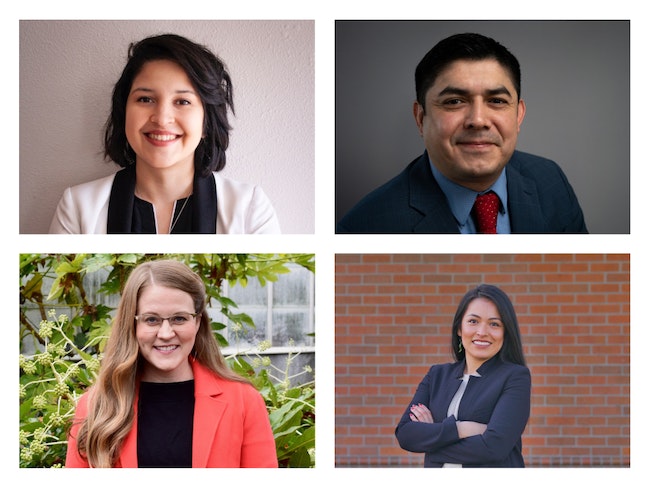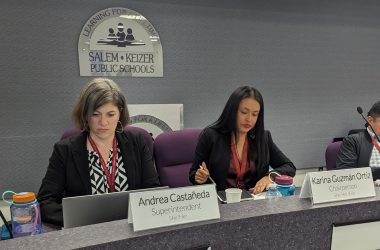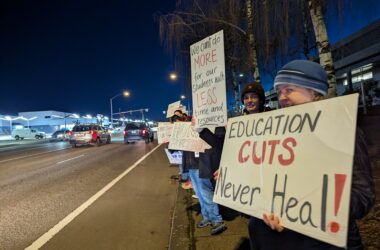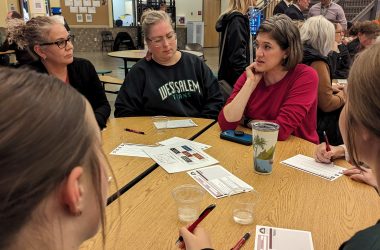 Newly elected members of the Salem-Keizer School Board for 2021, from top left: María Hinojos Pressey, Osvaldo Avila, Ashley Carson Cottingham and Karina Guzmán Ortiz.
Newly elected members of the Salem-Keizer School Board for 2021, from top left: María Hinojos Pressey, Osvaldo Avila, Ashley Carson Cottingham and Karina Guzmán Ortiz.
Salem’s educators face a daunting task in the fall: helping more than 40,000 local students return to classrooms full-time, and addressing the academic and mental health needs of students who missed more than a year of in-person instruction.
Overseeing their work will be four new members of the Salem-Keizer School Board, who won election in May.
Osvaldo Avila, Ashley Carson Cottingham, Karina Guzmán Ortiz and María Hinojos Pressey will have their first meeting Tuesday, July 13. They join current board members Satya Chandragiri, Danielle Bethell and Marty Heyen, who are halfway through their four-year terms.
The relatively junior board takes office as Oregon’s second largest school district grapples with multiple overlapping challenges, including returning to something resembling normal school and reworking how schools discipline students and keep them safe in the wake of Superintendent Christy Perry’s controversial decision in the spring to end contracts stationing police officers at local schools.
“They’re just going to have to get their feet on the ground really quick,” Perry said. “We’ll be working on hard things right off the bat.”
The four won election as a slate of candidates backed largely by liberal and progressive groups in Salem, including Pineros Y Campesinos Unidos del Noroeste, Oregon’s farmworker union, and Progressive Salem.
Their election flips the political balance of the board – Chandragiri, Bethell and Heyen were all backed by conservative groups, including Oregon Right-to-Life, which endorsed an opposing slate of four board candidates in May.
In interviews with Salem Reporter, all seven board members said that while they expect to disagree over some issues, they want to work together and keep the board’s focus on serving students.
“We have a board with different, perhaps, perspectives or values than our previous board, but we have to come together … to work together and think about our students,” Guzmán Ortiz said. “That includes creating some form of trust between board members and then expanding that” to the community.
Chandragiri, who’s served as chair for the past year, endorsed the new board members’ opponents in all four races. But he said his new colleagues are “amazing people” and will do good work.
“I have full faith in them and I will work to ensure they will do very well and succeed,” he said.
Despite the heated rhetoric of the campaign, Chandragiri said parents who disagree with the newcomers politically don’t need to fear radical shifts in district operations or policy.
Salem-Keizer’s school board takes a relatively hands-off role in the day-to-day operations of the district. The board’s chief responsibilities are to hire and evaluate the superintendent, set goals for her performance and approve the district’s $1 billion annual budget.
Decisions about curriculum, health protocols and day-to-day operations are left in the hands of district administrators.
“Nobody can take over anything. There are so many checks and balances,” Chandragiri said.
Bethell, the outgoing vice chair, agreed.
“Education shouldn’t be political. I don’t believe a major shift will occur,” she said in an email.
Changing demographics
The newcomers make for a board that much more closely tracks the demographics of the students in the district.
Avila, Guzmán Ortiz and Hinojos Pressey are the first Latino representatives ever elected in Salem-Keizer. Local schools are about 44% Latino, a share that’s climbing.
All three are bilingual in Spanish and English and said they hope their backgrounds will make the boardroom a more welcome place for Spanish-speaking parents and students to voice their concerns.
“We can bring in that different perspective of having been that child growing up in a district that maybe made you feel like you weren’t really being acknowledged or listened to,” Hinojos Pressey said.
 School board director Satya Chandragiri with a portrait drawn by a district student (Rachel Alexander/Salem Reporter)
School board director Satya Chandragiri with a portrait drawn by a district student (Rachel Alexander/Salem Reporter)
With Chandragiri, a naturalized U.S. citizen born in India, they’ll make the board the first in district history with a majority being directors of color.
They also bring experience in education policy. Avila works for Oregon’s Higher Education Coordinating Commission as a grant administrator focused on talent, equity and innovation. Guzmán Ortiz works for the Early Learning Division, focused on outreach to child care providers, and is a former substitute teacher in the district.
More board members than in recent years have children currently enrolled in district schools.
Heyen and Chandragiri are parents of Salem-Keizer graduates, but Guzmán Ortiz, Carson Cottingham, Avila and Bethell have students ranging from elementary to high school. Hinojos Pressey’s daughter, who’s currently three, will join them before her mother’s term is up.
Guzmán Ortiz said being a current parent helps her understand where the district is serving families well and where things could be improved. Better communication is one example.
She said she was surprised by the announcement at the end of the school year that start times would be flipped, with most elementary school students beginning class at 7:50 a.m. and middle and high schoolers starting later in the morning. The change had major implications for child care and family schedules but felt like it came out of the blue for many parents, she said.
“For me, that was an example of: how are we communicating with families and how can we improve that communication?” she said.
Reworking public engagement
New board members aren’t coming into office with sweeping agendas to overhaul district operations. But all four said changing the way the board handles public comment during meetings – and community input more generally – is high on their list of priorities.
“Having the opportunity for public engagement and participation is pretty foundational to the way that we develop policy in this country, and so I think it’s really important to reestablish a wide variety of opportunities for people to provide input and inform the school board going forward,” Carson Cottingham said.
A series of contentious meetings in the summer of 2020 about the presence of police officers in local schools led Chandragiri to put forward a proposal limiting public comment offered during meetings to written submissions, rather than live call-ins.
Chandragiri said the change was in response to calls often being dominated by members of Latinos Unidos Siempre, a youth group that’s been critical of both the board and district administrators over discipline practices and disparate treatment of students of color.
 Students organized by Latinos Unidos Siempre urged the new Salem-Keizer School Board to address the mental health needs of immigrant students and stop policies that disproportionately punish students of color at a July 2019 meeting. (Rachel Alexander/Salem Reporter)
Students organized by Latinos Unidos Siempre urged the new Salem-Keizer School Board to address the mental health needs of immigrant students and stop policies that disproportionately punish students of color at a July 2019 meeting. (Rachel Alexander/Salem Reporter)
The board resumed in-person meetings in the spring, but those meetings have remained closed to the public and viewable only via livestream.
That’s led Latinos Unidos Siempre members to stage protests in the parking lot outside, banging on the windows, playing music and blowing air horns. The group is seeking statements from board leadership condemning white supremacy in Salem, as well as a commitment that money once spent on police officers in schools will be reinvested in mental health supports for students of color.
At a June 15 meeting, the outgoing board voted 5-2 to establish a “free speech zone” limiting where protests could take place outside the boardroom. Chandragiri proposed the change to prevent protests from disrupting meetings.
Avila said the situation reflected a breakdown in trust and communication.
“I think they’ve escalated the situation by not addressing public comment,” he said of the previous board. “We’re still not listening to the groups, we’re still not listening to families. We’re just going to push them away further and say, ‘Here, we provided you a space to protest,’ but they’re not really being heard. That’s not healthy. That’s not building bridges.”
The board hasn’t yet made plans to resume fully in-person meetings open to the public, but that’s likely to be a topic of discussion at Tuesday’s meeting.
Graduation gaps
Addressing gaps in graduation rates for marginalized students is another priority.
While the district’s overall graduation rate has climbed in recent years and sat at 81% in 2020, there remain large gaps among certain groups of students.
Black, Native American and Pacific Islander students, students with disabilities, homeless students and students who aren’t fluent in English by high school graduate at far lower rates than the district average, despite recent improvements.
“I think it’s a combination of not engaging our students and also driving them away through disproportionate discipline,” Avila said of the gaps. District data shows Black, Latino, Native American and Pacific Islander students are more likely to be suspended and expelled than their white and Asian peers.
 Graduate Alexis Garcia’s decorated cap, during the the Early College High School and Roberts Teen Parent Program combined graduation ceremony at Sprague High School on Thursday, August 6. (Amanda Loman/Salem Reporter)
Graduate Alexis Garcia’s decorated cap, during the the Early College High School and Roberts Teen Parent Program combined graduation ceremony at Sprague High School on Thursday, August 6. (Amanda Loman/Salem Reporter)
Mental health services remain a focus for all board members, especially as students recover from a challenging year.
Avila said he’d like to see expanded mental health and social services available for families, and district contracts with agencies that can provide counseling in languages other than English. Current services aren’t always practical for working parents and students with after school responsibilities.
“A lot of our providers end at 5 o’clock. Our families don’t end at five o’clock. Our families are working. Our students are working,” he said.
Heyen will be the only board member serving a second term and said it’s no secret her conservative politics are “180 degrees” from those of the incoming board members.
She was a frequent target of criticism during public comments last summer for her support of keeping police in schools and association with members of the Three Percent, a conservative militia group.
“I am honored to take over the ‘no’ votes for the next two years,” Heyen joked at the June 15 board meeting when saying goodbye to outgoing board member Paul Kyllo.
But in an interview, Heyen said she expects the board will be able to focus on education if new board members recognize they have a learning curve and can’t come in and change district operations overnight.
“My experience has been that the majority, if not all, board members come in with an idea of what they want to do or change and they usually find out that’s not how it works,” she said.
She recalled as a newly elected board member wanting schools to reinstate teaching cursive so students could read historical documents.
Kyllo asked her what she would take out of teachers’ already packed schedules to make room for the addition, helping Heyen realize changes weren’t so simple.
Board members will select a new chair and vice chair at their meeting Tuesday. Chandragiri and Bethell said they don’t intend to seek leadership positions again.
The board will also vote on approving a new contract with the Salem-Keizer Education Association, the union represents thousands of district teachers and licensed employees.
Tuesday’s meeting begins at 6 p.m. Members of the public can watch on CC:Media, channel 21, or on YouTube in English or Spanish.
Contact reporter Rachel Alexander: [email protected] or 503-575-1241.
JUST THE FACTS, FOR SALEM – We report on your community with care and depth, fairness and accuracy. Get local news that matters to you. Subscribe to Salem Reporter starting at $5 a month. Click I want to subscribe!

Rachel Alexander is Salem Reporter’s managing editor. She joined Salem Reporter when it was founded in 2018 and covers city news, education, nonprofits and a little bit of everything else. She’s been a journalist in Oregon and Washington for a decade. Outside of work, she’s a skater and board member with Salem’s Cherry City Roller Derby and can often be found with her nose buried in a book.









